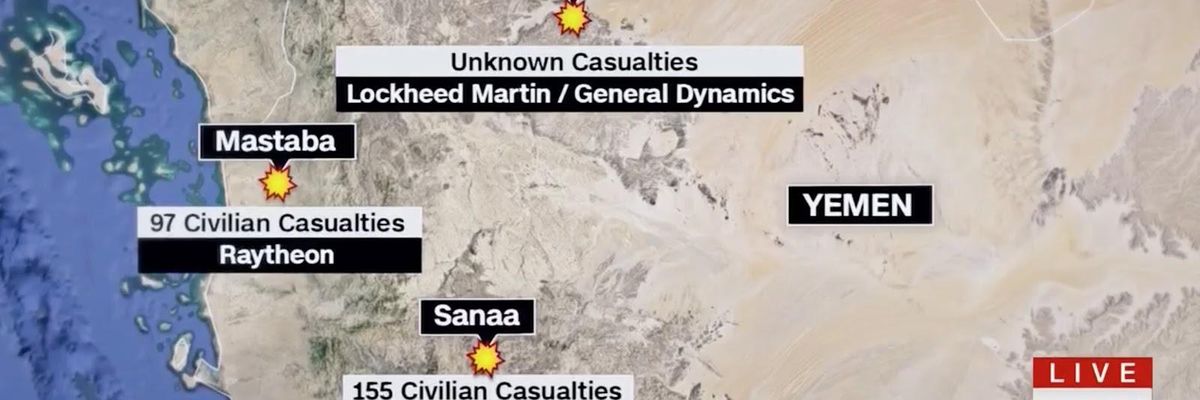
The companies see only the revenues on their balance sheets, which are always in the black, never in the red like the blood that flows from the real-world results of the weapons they produce. (Photo: Screenshot)
Bombing Yemeni School Children for Profit
Unfortunately, killing and maiming civilians with US weapons is a regular occurrence
As if the horrific Saudi bombing of a Yemeni school bus that killed 44 children on August 9, 2018 wasn't bad enough, CNN reported that the bomb used in the attack was manufactured by Lockheed Martin, one of the major U.S. defense contractors. Nima Elbagir, reporting for CNN's Situation Room, showed a map of Yemen pinpointing several other attacks where large numbers of civilians have been killed by bombs from not only Lockheed Martin, but also General Dynamics and Raytheon. It was a rare moment when a mainstream US media outlet made the connection between U.S. weapons and the devastation they wreak.
It was a rare moment when a mainstream US media outlet made the connection between U.S. weapons and the devastation they wreak.
The footage of the Yemen attack is heartbreaking, showing bloodied and screaming children (the 'fortunate' survivors) still wearing their blue backpacks. A global outcry for the Saudis to stop bombing civilians and for the US to stop selling weapons to Saudi Arabia arose immediately.
Israel has used American weapons for decades to maintain a 50-year-long hostile military occupation of Palestine and to turn Gaza into a 21st century version of the Warsaw Ghetto, policed with bombs, missiles, F-16s, Apache helicopters and snipers.
The companies see only the revenues on their balance sheets, which are always in the black, never in the red like the blood that flows from the real-world results of the weapons they produce.
A useful framework for understanding the forces driving the U.S. weapons industry is through the concept of the "military-industrial complex," which President Eisenhower warned against in his extraordinary farewell speech to the nation in 1961.
Small reductions in U.S. military spending were offset by increased U.S. arms sales to foreign governments. The Bush administration used the First Gulf War in 1991 as a showcase for the destructive power of U.S. weapons, carpet bombing Iraq with 88,500 tons of bombs and titillating American television audiences who, for the first time, could watch war in real time from the comfort and safety of their living rooms..
Following the First Gulf War (Desert Storm), the U.S. military redeployed its planes and pilots from Kuwait to the Paris Air Show, where they launched a marketing blitz that led to record U.S. weapons sales and exports over the next three years, paving the way for President Clinton's second term to be even more lucrative for U.S. arms merchants.
In a kind of perverse irony, the biggest bonanza for the arms industry was the September 11, 2001 attack on the World Trade Center. The U.S. wars in Afghanistan and Iraq served as a pretext for a massive increase in U.S. weapons spending. Between 1999 and 2011, the U.S. spent $1.3 trillion on its wars, but above and beyond that is the $1.8 trillion spent to buy new warplanes, warships, weapons and equipment, most of which were unrelated to wars the U.S. was actually fighting.
As Obama launched his 2012 reelection campaign on the strength of winding down U.S. military involvement overseas, General Dynamics' annual report presciently reassured its investors that "while the level of U.S. defense spending will be impacted by...fiscal realities, there is not a foreseeable peace dividend."
Sure enough, Obama's Department of Defense funding averaged $653.6 billion per year (in 2016 dollars), 3% more than under Bush Jr's, and 56% more than under Clinton. But, like Clinton in the 1990s, Obama offset small reductions in Pentagon weapons purchases with expanding foreign arms sales.
Then, as Trump took office in 2017, the Wall Street Journal predicted that "the global aerospace and defense (A&D) sector is likely to experience stronger growth in 2017 after multiple positive but subdued years," thanks to a "resurgence of global security threats, anticipated increases in U.S. defense budgets," and increased global arms sales. The Journal was right: the stocks of major arms producers hit record highs in 2017.
The time has come to look at the correlation between these record arms sales and the Saudi bombing of little school boys in Yemen, the Israeli shooting of peaceful protesters in Gaza, and the Egyptian government's record of extrajudicial killings and torture.
An Urgent Message From Our Co-Founder
Dear Common Dreams reader, The U.S. is on a fast track to authoritarianism like nothing I've ever seen. Meanwhile, corporate news outlets are utterly capitulating to Trump, twisting their coverage to avoid drawing his ire while lining up to stuff cash in his pockets. That's why I believe that Common Dreams is doing the best and most consequential reporting that we've ever done. Our small but mighty team is a progressive reporting powerhouse, covering the news every day that the corporate media never will. Our mission has always been simple: To inform. To inspire. And to ignite change for the common good. Now here's the key piece that I want all our readers to understand: None of this would be possible without your financial support. That's not just some fundraising cliche. It's the absolute and literal truth. We don't accept corporate advertising and never will. We don't have a paywall because we don't think people should be blocked from critical news based on their ability to pay. Everything we do is funded by the donations of readers like you. Will you donate now to help power the nonprofit, independent reporting of Common Dreams? Thank you for being a vital member of our community. Together, we can keep independent journalism alive when it’s needed most. - Craig Brown, Co-founder |
As if the horrific Saudi bombing of a Yemeni school bus that killed 44 children on August 9, 2018 wasn't bad enough, CNN reported that the bomb used in the attack was manufactured by Lockheed Martin, one of the major U.S. defense contractors. Nima Elbagir, reporting for CNN's Situation Room, showed a map of Yemen pinpointing several other attacks where large numbers of civilians have been killed by bombs from not only Lockheed Martin, but also General Dynamics and Raytheon. It was a rare moment when a mainstream US media outlet made the connection between U.S. weapons and the devastation they wreak.
It was a rare moment when a mainstream US media outlet made the connection between U.S. weapons and the devastation they wreak.
The footage of the Yemen attack is heartbreaking, showing bloodied and screaming children (the 'fortunate' survivors) still wearing their blue backpacks. A global outcry for the Saudis to stop bombing civilians and for the US to stop selling weapons to Saudi Arabia arose immediately.
Israel has used American weapons for decades to maintain a 50-year-long hostile military occupation of Palestine and to turn Gaza into a 21st century version of the Warsaw Ghetto, policed with bombs, missiles, F-16s, Apache helicopters and snipers.
The companies see only the revenues on their balance sheets, which are always in the black, never in the red like the blood that flows from the real-world results of the weapons they produce.
A useful framework for understanding the forces driving the U.S. weapons industry is through the concept of the "military-industrial complex," which President Eisenhower warned against in his extraordinary farewell speech to the nation in 1961.
Small reductions in U.S. military spending were offset by increased U.S. arms sales to foreign governments. The Bush administration used the First Gulf War in 1991 as a showcase for the destructive power of U.S. weapons, carpet bombing Iraq with 88,500 tons of bombs and titillating American television audiences who, for the first time, could watch war in real time from the comfort and safety of their living rooms..
Following the First Gulf War (Desert Storm), the U.S. military redeployed its planes and pilots from Kuwait to the Paris Air Show, where they launched a marketing blitz that led to record U.S. weapons sales and exports over the next three years, paving the way for President Clinton's second term to be even more lucrative for U.S. arms merchants.
In a kind of perverse irony, the biggest bonanza for the arms industry was the September 11, 2001 attack on the World Trade Center. The U.S. wars in Afghanistan and Iraq served as a pretext for a massive increase in U.S. weapons spending. Between 1999 and 2011, the U.S. spent $1.3 trillion on its wars, but above and beyond that is the $1.8 trillion spent to buy new warplanes, warships, weapons and equipment, most of which were unrelated to wars the U.S. was actually fighting.
As Obama launched his 2012 reelection campaign on the strength of winding down U.S. military involvement overseas, General Dynamics' annual report presciently reassured its investors that "while the level of U.S. defense spending will be impacted by...fiscal realities, there is not a foreseeable peace dividend."
Sure enough, Obama's Department of Defense funding averaged $653.6 billion per year (in 2016 dollars), 3% more than under Bush Jr's, and 56% more than under Clinton. But, like Clinton in the 1990s, Obama offset small reductions in Pentagon weapons purchases with expanding foreign arms sales.
Then, as Trump took office in 2017, the Wall Street Journal predicted that "the global aerospace and defense (A&D) sector is likely to experience stronger growth in 2017 after multiple positive but subdued years," thanks to a "resurgence of global security threats, anticipated increases in U.S. defense budgets," and increased global arms sales. The Journal was right: the stocks of major arms producers hit record highs in 2017.
The time has come to look at the correlation between these record arms sales and the Saudi bombing of little school boys in Yemen, the Israeli shooting of peaceful protesters in Gaza, and the Egyptian government's record of extrajudicial killings and torture.
As if the horrific Saudi bombing of a Yemeni school bus that killed 44 children on August 9, 2018 wasn't bad enough, CNN reported that the bomb used in the attack was manufactured by Lockheed Martin, one of the major U.S. defense contractors. Nima Elbagir, reporting for CNN's Situation Room, showed a map of Yemen pinpointing several other attacks where large numbers of civilians have been killed by bombs from not only Lockheed Martin, but also General Dynamics and Raytheon. It was a rare moment when a mainstream US media outlet made the connection between U.S. weapons and the devastation they wreak.
It was a rare moment when a mainstream US media outlet made the connection between U.S. weapons and the devastation they wreak.
The footage of the Yemen attack is heartbreaking, showing bloodied and screaming children (the 'fortunate' survivors) still wearing their blue backpacks. A global outcry for the Saudis to stop bombing civilians and for the US to stop selling weapons to Saudi Arabia arose immediately.
Israel has used American weapons for decades to maintain a 50-year-long hostile military occupation of Palestine and to turn Gaza into a 21st century version of the Warsaw Ghetto, policed with bombs, missiles, F-16s, Apache helicopters and snipers.
The companies see only the revenues on their balance sheets, which are always in the black, never in the red like the blood that flows from the real-world results of the weapons they produce.
A useful framework for understanding the forces driving the U.S. weapons industry is through the concept of the "military-industrial complex," which President Eisenhower warned against in his extraordinary farewell speech to the nation in 1961.
Small reductions in U.S. military spending were offset by increased U.S. arms sales to foreign governments. The Bush administration used the First Gulf War in 1991 as a showcase for the destructive power of U.S. weapons, carpet bombing Iraq with 88,500 tons of bombs and titillating American television audiences who, for the first time, could watch war in real time from the comfort and safety of their living rooms..
Following the First Gulf War (Desert Storm), the U.S. military redeployed its planes and pilots from Kuwait to the Paris Air Show, where they launched a marketing blitz that led to record U.S. weapons sales and exports over the next three years, paving the way for President Clinton's second term to be even more lucrative for U.S. arms merchants.
In a kind of perverse irony, the biggest bonanza for the arms industry was the September 11, 2001 attack on the World Trade Center. The U.S. wars in Afghanistan and Iraq served as a pretext for a massive increase in U.S. weapons spending. Between 1999 and 2011, the U.S. spent $1.3 trillion on its wars, but above and beyond that is the $1.8 trillion spent to buy new warplanes, warships, weapons and equipment, most of which were unrelated to wars the U.S. was actually fighting.
As Obama launched his 2012 reelection campaign on the strength of winding down U.S. military involvement overseas, General Dynamics' annual report presciently reassured its investors that "while the level of U.S. defense spending will be impacted by...fiscal realities, there is not a foreseeable peace dividend."
Sure enough, Obama's Department of Defense funding averaged $653.6 billion per year (in 2016 dollars), 3% more than under Bush Jr's, and 56% more than under Clinton. But, like Clinton in the 1990s, Obama offset small reductions in Pentagon weapons purchases with expanding foreign arms sales.
Then, as Trump took office in 2017, the Wall Street Journal predicted that "the global aerospace and defense (A&D) sector is likely to experience stronger growth in 2017 after multiple positive but subdued years," thanks to a "resurgence of global security threats, anticipated increases in U.S. defense budgets," and increased global arms sales. The Journal was right: the stocks of major arms producers hit record highs in 2017.
The time has come to look at the correlation between these record arms sales and the Saudi bombing of little school boys in Yemen, the Israeli shooting of peaceful protesters in Gaza, and the Egyptian government's record of extrajudicial killings and torture.

